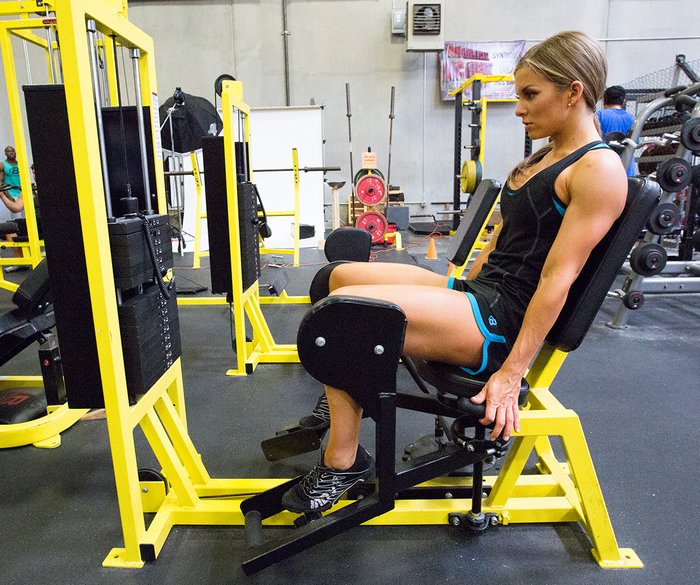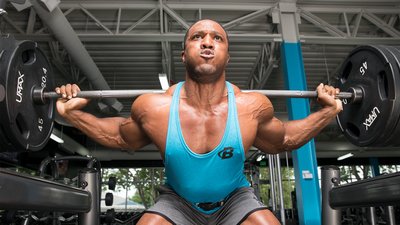It's an old story: You start out squatting light and it feels OK. Then, shortly after the initial rise in strength, you injure yourself when you try to go heavier on your squat. Plenty of people experience this over and over again, almost as regularly as the seasons change. They make a little short-term progress, but injuries keep holding them back from making progress over the long haul.[1]

So what's the culprit causing this vicious cycle? You might think the lower back or sacroiliac joint is to blame, since that's where most people actually experience a squat-related injury, but that may just be the expression of weakness elsewhere.
Luckily, there's something you can do to significantly improve your squat form, while decreasing your risk of injury.[2] And the best part is, it's easy and will only take a couple of minutes at the start of your squat workout.
The Real Weak Links
Why do squat injuries happen? The main culprit is muscular imbalance.[2-5] You kept improving the strength of your big muscle groups, but completely neglected the most important stabilizer groups. So while the biggest muscles powering your squat—the quads and glutes—get stronger, the weakest links in the chain remain as weak as ever.
Some people will tell you that the answer is just to "squat better," but in this case, form corrections aren't enough. For instance, one common squatting cue intended to prevent injury is to "drive your knees out" to prevent knee valgus—or knees caving in. This is a great cue to optimize the squat mechanics, but there is one problem: Many people lack the ability to keep their knees "out" and their knees cave in during the squat anyway. In other words, you think you're employing good form, but you're actually not—and you're setting yourself up for inevitable injury.
Standard corrective exercise protocol to help fix this is to strengthen the hip abductors, especially the gluteus medius. Although it is a good idea to work these muscles, many people do not have disproportionally weak gluteus medius muscles, which means they are not the root of the problem.
In my professional experience, an athlete's inability to maintain "knees out" when squatting is more often due to weak rotators of the hip. The internal and external rotators of the hip play a crucial role in stabilizing the hips, knees, and lower back, keeping you safe while you squat.
How to Perform Rotations to Strengthen Your Hips
How can you strengthen your internal and external rotators and reduce your risk of injury? Simply perform isolated strengthening exercises that specifically target these important stabilizer muscles.
Isolation work for the hip rotators can be done with resistance bands or at any cable column:
- Lay on your back and attach the cable or resistance band around your lower leg.
- Keep your knee flexed at a 90-degree angle from the hip for both the internal and external rotation.
- Perform 2 sets of 10-15 reps of both the internal and external rotation.
Make sure you control both the concentric and eccentric movements, and stabilize your body so the only joint moving is your hip. You can gradually increase the number of sets you perform over time to increase total training volume and improve your strength.
This type of isolation training can be extremely beneficial to your compound movements and minimizes the development of imbalances over time. It can also make for stronger, deeper squats. Try it, and let me know in the comments if it works for you!
References
- Schoenfeld, B. J. (2010). Squatting kinematics and kinetics and their application to exercise performance. The Journal of Strength and Conditioning Research, 24(12), 3497-3506.
- Kulund, D. N., Dewey, J. B., Brubaker, C. E., & Roberts, J. R. (1978). Olympic weight-lifting injuries. The Physician and Sportsmedicine, 6(11), 111-119.
- Lawrence, R. K., Kernozek, T. W., Miller, E. J., Torry, M. R., & Reuteman, P. (2008). Influences of hip external rotation strength on knee mechanics during single-leg drop landings in females. Clinical Biomechanics, 23(6), 806-813.
- Khayambashi, K., Mohammadkhani, Z., Ghaznavi, K., Lyle, M. A., & Powers, C. M. (2012). The effects of isolated hip abductor and external rotator muscle strengthening on pain, health status, and hip strength in females with patellofemoral pain: a randomized controlled trial. Journal of Orthopaedic and Sports Physical Therapy, 42(1), 22-29.
- Shadmehr, A., Jafarian, Z., & Talebian, S. (2012). Changes in recruitment of pelvic stabilizer muscles in people with and without sacroiliac joint pain during the active straight-leg-raise test. Journal of Back and Musculoskeletal Rehabilitation, 25(1), 27-32.

